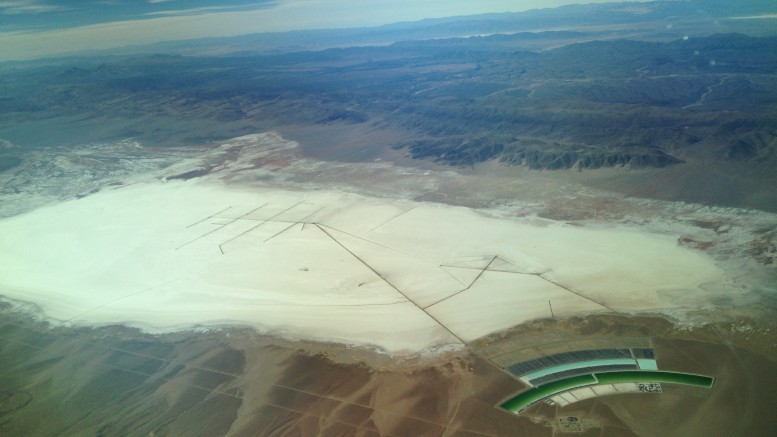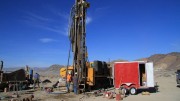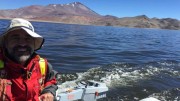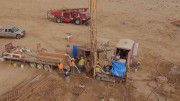VANCOUVER —While the burgeoning lithium market has sent companies scrambling to secure and advance lithium projects across the globe, anyone new to the scene may be left wondering what the fuss is all about.
And so The Northern Miner reached out to Andy Robinson, chief operating officer for Pure Energy Minerals (TSXV: PE), to describe the fundamentals of lithium deposits and how to understand the differences between projects.
Pure Energy entered the lithium business in 2009, and picked up its flagship Clayton Valley South property in 2011. The brine-hosted deposit is beside North America’s current sole lithium producer Albemarle (NYSE: ALB) and its Silver Peak operation, halfway between Reno and Las Vegas in Nevada.
“The lithium world is not like normal commodities … it’s highly technical, and there’s lots of tricky geology, hydrogeology and chemical engineering you have to solve to make it work,” Robinson says over coffee at a café near The Northern Miner’s Vancouver office. “Fundamentally you need the right team in place, otherwise you won’t be able to do anything with the project.”
Robinson has a doctorate in geochemistry, and cut his teeth on a variety of groundwater projects in the mineral and energy sectors for over a decade.
He explains that there are three types of lithium deposits: spodumene, clay and brine.
Spodumene is a lithium-bearing mineral found within coarse-grained granite pegmatite rock.
One reason why crystals in pegmatites are so unusually large is because lithium prevents magmatic melt from cooling too quickly, which gives the minerals more time to grow.
“Pegmatites are your classic hard-rock deposit that any miner can get their head around,” Robinson says. “They’re mostly in Australia, with Talison Lithium being the biggest producer right now. Then there’s a bunch in Quebec and some in the eastern U.S., but nothing there has been put into production yet.”
(An exception is beleaguered miner RB Energy — formerly Canada Lithium — at its Quebec Lithium spodumene mine, 60 km north of Val-d’Or, Que. The company began commissioning the mine in 2012, but ran into delays from commissioning problems with its kiln, which converted alpha spodumene to beta spodumene — the first step of the process to convert spodumene concentrate to lithium carbonate.
After a failed attempt to raise capital for the operation, RB Energy shuttered the mine in 2014 before it reached full capacity and filed for bankruptcy.)
But today’s resurgence in the lithium market has cast a new glow on the hard-rock projects in Quebec, with Nemaska Lithium (TSXV: NMX; US-OTC: NMKEF) being “one company that’s furthest along,” Robinson says. The company is nearing a construction decision at its spodumene Whabouchi lithium project, 300 km northwest of Chibougamau.
The project has open-pit proven and probable reserves of 20 million tonnes at 1.5% lithium oxide (Li2O) using a 0.4% Li2O cut-off, and underground proven and probable reserves of 7.3 million tonnes at 1.3% Li2O, using a 0.8% Li2O cut-off.

Core racks at Nemaska Lithium’s Whabouchi lithium project, 300 km northwest of Chibougamau. Credit: Nemaska Lithium
Lithium clay deposits are developed when intense hydrothermal fluids convert volcaniclastic rocks into hectorite, a lithium-rich clay. The lithium can also precipitate directly into clays from migrating groundwater.
“Clay deposits would be bulk-mined, but the processing is different, and there aren’t any deposits that have been commercialized yet,” he says. “The lithium is essentially locked in the clay minerals, so it requires more energy just to persuade the lithium back into solution.”
He says the more publicly known and “impressive” clay deposits include Lithium Americas’ (TSX: LAC) Lithium Nevada deposit — formerly known as Kings Valley — 100 km northwest of Winnemucca in northern Nevada, and Bacanora Minerals (TSXV: BCN) and partner Rare Earth Minerals’ (LSE: REM) Sonora Lithium project, 190 km northeast of Hermosillo, in northern Mexico’s Sonora state.
Lithium Nevada hosts 50.8 million tonnes of 0.3% lithium and 3.3% potassium for 843,000 tonnes lithium carbonate equivalent (LCE) and 1.7 million tonnes potassium. Indicated resources add 164 million tonnes of 0.3% lithium and 3.1% potassium for 2.5 million tonnes LCE and 5 million tonnes potassium. Both calculations assume a 0.2% lithium cut-off.
The Sonora Lithium project hosts 259 million indicated tonnes of 0.3% lithium and 1.4% potassium for 4.5 million tonnes LCE and 3.6 million tonnes potassium. Inferred resources add 160 million tonnes of 0.3% lithium and 1.3% potassium for 2.7 million tonnes LCE and 2.1 million tonnes potassium. Both calculations assume a 0.1% lithium cut-off.
Lithium brine deposits are formed when lithium is leached, transported, concentrated and held within salty groundwater in arid environments.
According to a Canaccord Genuity market report released in May, lithium brine deposits account for 78% of the world’s lithium resources, and 51% — or 90,000 tonnes — of global LCE production in 2015.
 Most brine deposits are found in what Robinson refers to as South America’s “lithium triangle,” tracing from the bottom of Bolivia into Argentina and the Atacama Desert in Chile.
Most brine deposits are found in what Robinson refers to as South America’s “lithium triangle,” tracing from the bottom of Bolivia into Argentina and the Atacama Desert in Chile.
Canaccord notes the world’s largest brine production is from a large salt flat called “Salar de Atacama” in Chile, where Sociedad Quimica y Minera de Chile (NYSE: SQM) and Albemarle produced 60,673 tonnes of LCE — or 34% of global LCE production — from their combined operations in 2015.
“There are only a handful of regions in the world with all the right geological vectors that come together to form a lithium brine deposit,” Robinson says.
“You find them in basins where there’s no water coming in or out — it’s just like a big bathtub in the middle of the desert that’s been sitting there for hundreds of millions of years, evaporating into salt lakes. Lithium loves being in solution. It gets leached from volcaniclastic rocks that are slightly elevated in lithium, and/or it’s introduced by geothermal systems. So it all comes in diluted, but becomes more concentrated through evaporation over time.”
Other than South America, he says, the only other region that makes “economic sense” for lithium brine production is in the Clayton Valley region of Nevada, where Albemarle has its Silver Peak operation.
The U.S. Geological Survey estimates that Silver Peak has yielded 300 million lb. LCE since starting production in 1966. Albemarle produced 5,000 tonnes LCE in 2015 — or 3% of global output — according to Canaccord’s report.
Robinson notes there are also lithium brines associated with oilsands — such as those found in Alberta — but says they’re “very much their own niche.”
“From a geological point of view, the oil field brines are something that happened 200 or 300 million years ago, whereas the lithium brines we’re more familiar with are still occurring to this day,” he says. “The oil and gas reservoirs often contain very saline groundwater that can be lithium enriched … but it hasn’t been looked at much yet.”
One example he offers is junior explorer Canadian International Minerals (TSXV: CIN). The company confirmed a joint-venture agreement with Noram Ventures (TSXV: NRM) in May, whereby Noram may earn a 50% interest in the Alberta Lithium Brine project, located in the heart of the Sturgeon Lake oil field in west-central Alberta.
The project hosts the Sturgeon Lake brine deposit, which has an inferred resource of 2 million tonnes LCE at grades of 67.5 milligrams lithium per litre in 5.7 billion cubic metres of water.
Robinson explains that producers typically pump out lithium-enriched brines through a series of wells, and flush the water into a pond where the lithium concentrates via evaporation over time.
The concentrate is treated with sodium carbonate, known as “soda ash,” to precipitate lithium carbonate, which can then be washed and purified for sale.
But Robinson says there are a number of limitations with this approach.
The evaporation process, he says, is “very slow,” taking up to a year even in the most favourable conditions — such as the Atacama Desert — before a company can start processing the concentrate into a “useful product.”
In Nevada, where temperatures are cooler, he says it can take “up to two years to go from pump to a product you can sell.”
And if there’s a sudden rainstorm, or unpredictable weather, the pond becomes diluted and the evaporation process is set back.
“The conventional way of mining brines is just not efficient enough … lithium mining is much more of a chemical market than it is your typical mining mentality. You want to make a product people want to buy and use in batteries as efficiently as possible,” he says.
As a result, Robinson says Pure Energy has enlisted technology-leader Tenova Bateman Technologies and steelmaker Posco to develop a lithium processing technology that could slash production time to under 48 hours and eliminate the need for evaporation ponds.
The company expects results from the processing trials later this year.
Canaccord analyst Reg Spencer told The Northern Miner in an email that new lithium extraction technologies are listed as one of the risks in his firm’s supply forecasts, and to date “none have been proven to work on a commercial scale.”
According to Canaccord’s market report, lithium demand could jump 81% to 347,000 tonnes LCE by 2020, and by 259% to 687,000 tonnes by 2025, with 38% of demand from lithium-ion based electric vehicles, and 14% from the grid storage sector.
The firm predicts lithium carbonate prices could rise from US$6,000 per tonne in 2015 to US$10,500 per tonne by 2025, with spodumene concentrate prices increasing from US$450 per tonne to US$725 per tonne over the same period.
Global supply was at 176,000 tonnes LCE in 2015, with production dominated by six operations owned by four major mining companies, including Albemarle, SQM, FMC (NYSE: FMC) and Sichuan Tianqi Lithium Industries.
The report states that out of the 19 advanced projects across the globe, only a handful of new projects are likely to go into production before 2019 — most of which are spodumene, hard-rock lithium deposits.
Projects noted include Galaxy Resources and General Mining at their Mt Cattlin spodumene project near Ravensthorpe, Western Australia; Jiangxi Ganfeng Lithium, Mineral Resources and Neometals’ Mt Marion spodumene project, 40 km from Kalgoorlie, Western Australia; Pilbara Minerals’ Pilgangoora spodumene project, 90 km from Port Hedland, Western Australia; Altura Mining’s Pilgangoora spodumene project located next to Pilbara Minerals’ Pilgangoora project; Orocobre’s (TSX: ORL) Salar de Olaroz in northwest Argentina’s Jujuy province; and Galaxy’s Sal de Vida lithium brine project in Argentina’s Catamarca and Salta provinces.
Galaxy describes Sal de Vida as one of the largest and highest-quality undeveloped brine deposits in the world.
The brine deposit has measured and indicated resources of 4.1 million tonnes LCE at grades of 782 milligrams lithium per litre. Inferred resources add 3.2 million tonnes LCE at 718 milligrams lithium per litre. Both calculations assume a cut-off of 500 milligrams lithium per litre.
If these new entrants advance to production, Canaccord predicts there could be a modest lithium oversupply in 2018 and 2019, before balancing in 2021, and another 510,000 tonnes LCE may be needed by 2025.
To meet the projected demands, exploration for lithium deposits has heated up among junior explorers.

Lithium Americas Cauchari-Olaroz lithium brine project in northern Argentina. Credit: Lithium Americas
Robinson says that many have chosen to “ride the lithium brine wave,” because production costs are “much lower” than those at hard-rock operations, considering operators don’t have to drill, blast, excavate and haul ore.
But impurities within the brine — such as magnesium, boron, calcium and strontium — could increase capital and operating costs, as well as production time.
“Your lithium content can be lower if there’s not a lot of other stuff in the brine with it,” he says. “The chemistry of the brine is really important — other elements in there can really make processing difficult.”
But Robinson remains upbeat on the lithium sector. “This is not just a boom and bust cycle. The fundamentals are there that lithium demand will keep growing.”





Excellent informative article on Li…but why was not Nevada Sunrise Gold Corp (Nasdaq NVSGF) mentioned. They have Li near the Albamerle deposits in Nevada.
Hey there Henry, thanks for the inquiry! There have been a lot of new entrants flushing into Clayton Valley over the past year, Nevada Sunrise certainly being one of them! While all the properties in the district show promise, unfortunately, I just didn’t have enough space in the article to acknowledge all of them! That being said, I hope I get an opportunity to write about Nevada Sunrise sometime in the future and i’ll be keeping my eye on that space. Thank you for your readership!